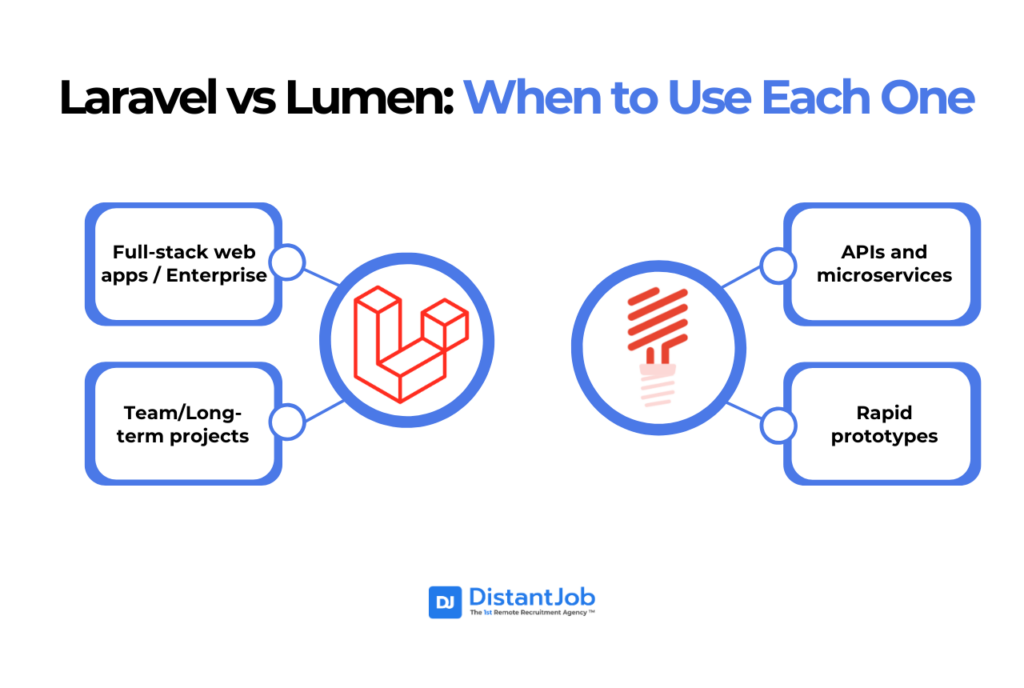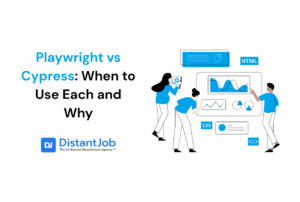Laravel vs Lumen 2025: Which PHP framework should you choose? Laravel is a full-stack framework for complete web applications, while Lumen is a lightweight micro-framework optimized for APIs and microservices with faster performance and smaller memory usage.
Think of it this way: choose Lumen when raw speed and lightweight scalability matter more than extra features, or an internal microservices cluster. Choose Laravel when you need rich views, complex business logic, or lots of third-party integration, and if you still want extra performance, you can bolt on Laravel Octane, which swaps the default PHP worker for Swoole or RoadRunner and can boost request throughput by up to 10 times.
Let’s dive deeper into these differences and explore how to use each.
Laravel vs Lumen: Architecture & Differences
Both frameworks use the MVC pattern, Laravel’s service container, Eloquent ORM, Blade templates, and most of Laravel’s core components. In fact, the Lumen documentation notes that migrating a Lumen project to Laravel couldn’t be easier – you can drop Lumen’s code into a Laravel app without changes.
To stay minimal, Lumen omits or disables parts of Laravel by default. For example, HTTP sessions, cookie encryption, CSRF protection, and HTML form requests are not enabled in Lumen unless explicitly added. Built-in tools like Laravel’s route caching and some CLI generators simply do not exist in Lumen (the “route:cache” command is unavailable in Lumen, and Lumen lacks jobs/queue generators). The trade-off is fewer layers in the bootstrap process: Lumen’s entire app is essentially one file, which reduces overhead.
Lumen also uses a faster router (FastRoute) instead of Laravel’s Symfony-based router. It also omits the HTTP kernel and default middleware stack. Laravel 11 even streamlines its structure (fewer files, no Http/Kernel, configurable routing and middleware in code), whereas Lumen was already minimal. In practice, Lumen is stateless by default – it responds with JSON and no session support, making it lean for APIs.
In summary, Laravel is a comprehensive framework with many features and conventions, while Lumen is a stripped-down variant optimized for simplicity and speed. Both share the same core (MVC, container, Eloquent), but Lumen trades away features like session state and some CLI tooling to reduce latency.
Lumen’s only purpose is to build lightning-fast microservices and APIs, leveraging Laravel’s foundation with almost zero configuration.
Laravel vs Lumen: Performance and Speed
Lumen was introduced as a high-performance alternative to Laravel, and indeed, historically, benchmarks and claims have highlighted its speed. It shouldn’t be a surprise; it was built for that.
Lumen is “built for performance”: it uses a minimal bootstrap and leaner middleware, so in micro-benchmarks, a Lumen route can respond in a few milliseconds. For example, an AWS Lambda test reported by Pietro Iglio, Lumen serving a static response in ~2.5 ms (warm start) versus ~7–8 ms for Laravel.
It’s worth mentioning that, despite Lumen being way faster than Laravel, it is still dead last than other options in many benchmarks, often because Laravel (especially with Octane) can achieve comparable throughput. Indeed, Laravel 11 includes Octane (Swoole/RoadRunner integration) and FrankenPHP support, which can dramatically boost performance for concurrent workloads.
In fact, the official Lumen docs now state that due to PHP improvements and Octane’s availability, “we no longer support beginning new projects with Lumen” and recommend starting with Laravel instead.
In short, raw request speed tends to favor Lumen (less code to run per request), but in 2025, the gap is narrow. Both frameworks can serve thousands of requests per second on modern PHP, and factors like database I/O or network latency usually dominate.
Overall, if raw framework overhead is critical, Lumen may be slightly leaner. But for typical applications, both frameworks are performant, and Laravel’s broader features usually justify its modest overhead.
Laravel vs Lumen: Features and Ecosystem
As of 2025, Laravel continues to expand its ecosystem (Blade components, Tailwind presets, etc.), whereas Lumen mostly remains at core Laravel parity without major new features (and Laravel docs now effectively focus on Laravel, not Lumen).
Laravel Features
Laravel offers a rich out-of-the-box feature set: an elegant Blade templating engine, a powerful ORM (Eloquent), comprehensive authentication/authorization, middleware, caching, queued jobs, mail, testing tools (PHPUnit, Dusk), and more.
It also has many first-party packages (Sanctum, Passport, Cashier, Horizon, Telescope, Vapor, etc.) and a huge third-party ecosystem via Composer. Laravel’s artisan CLI can scaffold controllers, models, resources, and more, speeding development.
The Laravel 11 release added things like WebSockets (Reverb), health monitoring routes, rate-limiting, and a streamlined directory structure for fast startup. In short, Laravel is a full-stack framework ideal for complex apps.
In summary, Laravel’s core features include:
- Blade templating with view inheritance
- Eloquent ORM and database migrations
- Comprehensive authentication (guards, providers)
- Middleware and request lifecycle (with route caching)
- Artisan generators (controllers, models, policies, etc.)
- Queues, events, notifications, and cache drivers
- Rich ecosystem tools (Horizon for queues, Vapor for serverless, Octane for Swoole).
Lumen Features
Lumen retains many Laravel capabilities but in a minimal form. It supports Eloquent, routing, middleware, caching, queues, and validation (through the same components). However, Lumen lacks some Laravel niceties.
For example, the feature “Blade views” works only in Laravel, and if you need it, you have to import your Lumen project into Laravel.
Mail, queues, and most services work identically to Laravel’s, with a note that Lumen has no generators (you must copy the included ExampleJob to create new jobs). Configuration is light – many settings are in .env – but you can publish Laravel config files to Lumen if needed. Notably, Laravel packages like Cashier or Passport have no plug-and-play in Lumen; the docs say to switch to full Laravel if you need those.
Lumen’s feature highlights include:
- Eloquent ORM and DB support (lightweight, no generators).
- Routing and middleware (very fast routing with FastRoute).
- Built-in validation and simple authentication (JWT or custom) for APIs.
- Caching and queue support (same drivers as Laravel).
- Minimal configuration for fast boot (just enable Facades or Eloquent if needed).
- Lightweight service container and many Illuminate components identical to Laravel.
Despite its slimness, Lumen still “utilizes all benefits of Laravel” like security, DB configuration, queue services, etc., making it suitable for API services. However, the trade-off is that you must manage anything not included yourself.
Developer Experience and Community
Laravel demands more initial setup and has more conventions (PSR structure, MVC folders, etc.), but provides powerful generators and built-in tools. Lumen is leaner and quicker to bootstrap, but requires manual wiring for some features. Laravel’s ecosystem (Laracasts, Nova, Vapor, Forge, etc.) is far larger. In 2025, most developers will default to Laravel for new work, resorting to Lumen only when a truly minimal microservice is needed (if at all).
Laravel Community
Laravel offers a rich development environment. Its extensive documentation, Laracasts tutorials, and large community mean help is easy to find. The framework includes many “batteries” (like scaffolding, Passport, Cashier, Horizon, etc.) that cover common needs. Setup (laravel new) generates a full directory structure.
Artisan is full-featured, and debugging is eased by detailed error pages (via Whoops) and built-in logging. Laravel’s learning curve is moderate, but once learned, it speeds up the development of complex apps. The community also actively contributes packages and new features (e.g., Laravel 11’s enhancements).
I mean, Lumen is part of Laravel’s ecosystem. That should be enough said.
Lumen Community
Meanwhile, Lumen’s developer experience is simpler. A new Lumen app comes with far fewer files, so booting an app takes less time. Its documentation is concise and points to Laravel docs for most use-cases.
Developers familiar with Laravel will find Lumen very easy: it uses the same syntax and conventions where applicable. However, Lumen has fewer commands. For example, it lacks CLI commands. For those who don’t know a CLI command is a command you insert in a terminal, like your Windows’ cmd.exe.
You often need to write code by hand (e.g., create a Controller file manually) or use community packages. Because it is stateless, Lumen always returns JSON errors for validation and doesn’t include session-based helpers.
On the flip side, this simplicity means there are fewer pitfalls – Lumen won’t accidentally start a session or load unneeded services.
The Lumen community is smaller but focused on APIs and microservices. Many resources for Laravel apply, but some Laravel packages won’t work without tweaks. Notably, Laravel’s own guidance now steers new projects away from Lumen, reflecting that even PHP’s performance has improved enough that full Laravel (with Octane) can meet most API needs.
Laravel vs Lumen Comparison Sheet
Here is a comparison between the Laravel and Lumen frameworks.
| Laravel | Lumen | |
| Architecture | Full-stack framework | Micro-framework |
| Performance | Slower (unless Octane is in game) | Faster |
| Usage | Ideal for large projects, with a user interface and integrations | Ideal for small projects, especially Stateless APIs and microservices. |
| Integration | Many integration options to third-party services | Limited integration options |
| Request | Handles HTTP requests | Limited options in request handling |
| Routing | Define different routing | Restrict routing options |
Laravel vs Lumen: When to Use Each
Ultimately, the choice depends on project requirements and team expertise. If in doubt, Laravel is generally safer for future needs (and Laravel docs even guide Lumen users to upgrade to Laravel). But if your project is a high-performance microservice or API gateway, Lumen (or another micro-framework) can deliver maximum speed with minimal fuss.
When to use Laravel
Laravel shines for full-stack web applications. If your project needs server-rendered pages, complex business logic, user authentication, admin panels, or e-commerce features, Laravel is the clear choice.
It excels at medium-to-large projects (even enterprise) with built-in tools for security, testing, and team workflows. Real-world examples include content management, payment gateways, and customer portals – for instance, major companies like BBC, MasterCard, and Toyota have used Laravel for their CMS and payment systems.
Laravel’s broad feature set means you can rapidly build and scale such applications. Its Blade templates and frontend scaffolding also simplify building modern SPAs or traditional sites. In short, choose Laravel for any application requiring the full Laravel “ecosystem”.
When to use Lumen
Lumen is best suited for microservices and lightweight APIs. It was designed for stateless services where minimal latency and overhead are important. Typical use cases include JSON, REST APIs for mobile apps, internal data services, or high-throughput endpoints.
For example, companies like Uber and Trivago reportedly used Lumen to power their backend APIs, handling real-time data and large traffic smoothly.
Lumen is appropriate if you need a simple JSON API (e.g., a service returning data from a database or an external API) and you want the lowest possible footprint. It’s also useful in serverless environments (AWS Lambda) where cold-start times are critical.
However, note that even for APIs, modern Laravel (with Sanctum/Passport and Octane) can often meet performance needs, and you have more options.

Use-Case Summary
Full-stack web apps / Enterprise → Laravel
Rich features, templating, admin UI, complex data models, etc..
APIs and microservices → Lumen
Lean, stateless services where every millisecond counts.
Rapid prototypes → Lumen
Lumen can spin up very quickly, but today Laravel (with –minimal preset or early Octane) can be nearly as light.
Team/Long-term projects → Laravel.
Stronger ecosystem, tools, and community support. Lumen is a niche.
Conclusion
Laravel and Lumen are both PHP frameworks created by Taylor Otwell, but they target different scopes.
Laravel is a full-featured MVC framework with a rich ecosystem (ORM, templating, queueing, authentication, etc.) ideal for large web applications.
Lumen is a lightweight “micro-framework” built on the same Laravel components, intended for small apps and APIs. Lumen strips out non-essential features (sessions, cookies, form requests, etc.) to minimize overhead.
In 2025, Laravel continues to evolve (e.g., Laravel 11 with Octane and Reverb) and is the recommended starting point for new projects, while Lumen remains supported mainly for legacy microservices or very thin APIs. This article compares their architecture, performance, features, and ideal use-cases, with up-to-date insights and benchmarks.
In 2025, Laravel vs Lumen boils down to “full-featured versus ultra-light”, similar to Visual Studio vs VSCode. Laravel remains a leading full-stack PHP framework with a vibrant ecosystem and continual updates (e.g. Laravel 11’s new features). Lumen is Laravel’s official micro-framework, offering a lean, fast option for APIs. However, Lumen’s core team has signaled that Laravel (especially with Octane) now covers most performance needs. In practice, both can build APIs, but Laravel is generally chosen for any project needing robust functionality, while Lumen is reserved for specialized high-speed microservices.
CTOs and architects: use Laravel for web applications, SaaS, and any scenario demanding security, sessions, templating, or rapid feature development. Use Lumen (or consider Symfony/Slim/Phalcon) only for thin API endpoints or microservices where minimal overhead is paramount. Keep in mind that industry trends lean toward Laravel with performance enhancements (Vapor, Octane) as the go-to solution for both web and API workloads.
And if you ever need to hire a Laravel developer proficient with Lumen and any other skills, contact us. We will find you the best developer in the world, in less than two weeks. No fine print, no hidden fees.





